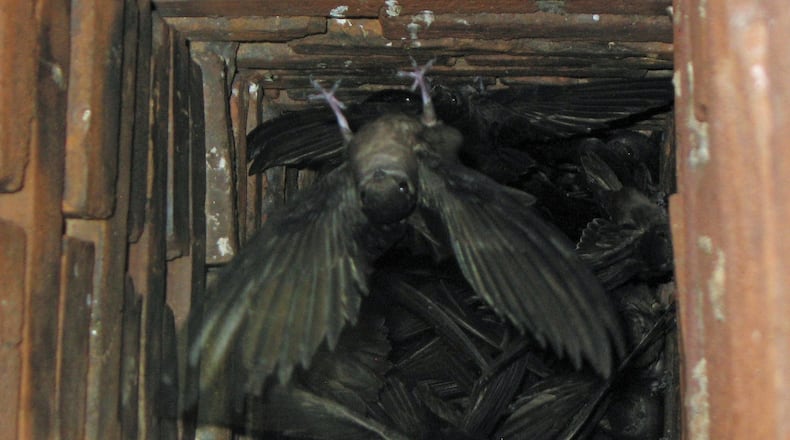For a crowd of us Atlanta Audubon Society birders, it was a most unusual bird-watching venue — the Clermont Hotel’s rooftop bar on Ponce de Leon Avenue in Atlanta.
We were atop the well-known city landmark around sunset last week for a grand view of a breathtaking sight a block away — hundreds of migrating chimney swifts plunging tornado-like into a large industrial chimney to roost for the night. We oohed and ahhed as the cigar-shaped, sooty gray birds with long, slender wings whirled, looped and darted about before folding back their wings and diving head-first into the chimney’s mouth.
During fall migration in October through early November, hundreds or thousands of southbound swifts roost together like this in large industrial chimneys or similar structures. Coming in around sunset, they put on their awe-inspiring aerial shows as they descend into the chimneys.
Incapable of perching because of very short, weak legs, swifts can only cling to rough surfaces such as masonry walls. Except when roosting and nesting, they constantly stay airborne, pursuing flying insects, drinking and even mating on the wing.
During summer, they nest mostly in masonry chimneys of homes and other structures. Most of their natural nest sites, such as old hollow trees, have been lost to development and other activities. They build half-saucer-shaped nests of twigs stuck together and cemented to a chimney wall with their glue-like saliva.
By late summer, their nesting season is over and they gather in large flocks to migrate to winter homes in the upper Amazon basin of Peru, Ecuador, Chile and Brazil. By mid-November, they’ll all be gone from Georgia until their return next spring.
IN THE SKY: From David Dundee, Tellus Science Museum astronomer:
The South Taurid Meteor Shower, visible this weekend, reaches a peak of about 10 meteors per hour on Monday night. Best viewing: In the east from about midnight until dawn.
The moon is first-quarter on Monday. Venus is very low in the west just after dark and sets shortly thereafter. Mars is low in the east just before dawn. Jupiter is low in the southwest around dusk and sets soon after. Saturn is low in the south just after dark and sets in the west about three hours later.
About the Author
Keep Reading
The Latest
Featured


